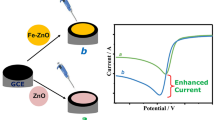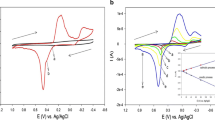Abstract
In this study, manganese(IV) oxide (MnO2) nanoparticle (np)-modified glassy carbon paste electrode is used for ascorbic acid (AA) detection in fruit juice samples. The experimental parameters like MnO2 np amount and pH were optimized by using modified full factorial design model. By means of this model, the number of experiments has been reduced. Under optimal conditions, the linear range for AA was obtained between 2.64 × 10−6 and −1.5 × 10−3 M. Limit of detection (LOD) (3 s/m) and relative standard deviation (RSD) were calculated as 8 × 10−7 M and 4.56 %, respectively. Developed sensor was applied to AA detection in fruit juice samples.




Similar content being viewed by others
References
Amiri M, Imanzadeh H, Banaei A (2015) Carbon nanoparticles with tosyl functional group for distinguishing voltammetric peaks of ascorbic acid and uric acid. Mater Sci Eng C 47:189–195
Bai YH, Du Y, Xu JJ, Chen HY (2007) Choline biosensors based on a bi-electrocatalytic property of MnO2 nanoparticles modified electrodes to H2O2. Electrochem Commun 9:2611–2616
Cevik S, Anik U (2010) Banana tissue-nanoparticle/nanotube based glassy carbon paste electrode biosensors for catechol detection. Sens Lett 8:667–671
Habibi B, Jahanbakhshi M, Pournaghi-Azar HM (2011) Differential pulse voltammetric simultaneous determination of acetaminophen and ascorbic acid using single-walled carbon nanotube-modified carbon–ceramic electrode. Anal Biochem 411:167–175
Hocevar SB, Ogorevc B, Schachl K, Kalcher K (2004) Glucose microbiosensor based on MnO2 and glucose oxidase modified carbon fiber microelectrode. Electroanalysis 16:1711–1716
Hosseini MG, Faraji M, Momeni MM (2011) Application of titanium oxide nanotube films containing gold nanoparticles for the electroanalytical determination of ascorbic acid. Thin Solid Films 519:3457–3461
Hu G, Ma Y, Guo Y, Shao (2008) Electrocatalytic oxidation and simultaneous determination of uric acid and ascorbic acid on the gold nanoparticles-modified glassy carbon electrode. Electrochim Acta 53:6610–6615
Jirimali HD, Nagarale RK, Saravanakumar D, Lee JM, Shin W (2013) Hydroquinone modified chitosan/carbon film electrode for the selective detection of ascorbic acid. Carbohydr Polym 92:641–644
Kit-Anan W, Olarnwanich A, Sriprachuabwong C, Karuwan C, Tuantranont A, Wisitsoraat A, Srituravanich W, Pimpin A (2012) Disposable paper-based electrochemical sensor utilizing inkjet-printed polyaniline modified screen-printed carbon electrode for ascorbic acid detection. J Electroanal Chem 685:72–78
Lin Y, Cui X, Liyu L (2005) Low-potential amperometric determination of hydrogen peroxide with a carbon paste electrode modified with nanostructured cryptomelane-type manganese oxides. Electrochem Commun 7:166–172
Liu J-J, Chenc Z-T, Tanga D-S, Wanga Y-B, Kanga L-T, Yaoe J-N (2015) Graphene quantum dots-based fluorescent probe for turn-on sensing of ascorbic acid. Sensors Actuators B 212:214–219
Luo XL, Xu JJ, Zhao W, Chen HY (2004a) A novel glucose ENFET based on the special reactivity of MnO2 nanoparticles. Biosens Bioelectron 19:1295–1300
Luo XL, Xu JJ, Zhao W, Chen HY (2004b) Ascorbic acid sensor based on ion-sensitive field-effect transistor modified with MnO2 nanoparticles. Anal Chim Acta 512:57–61
Mallesha M, Manjunatha R, Nethravathi C, Suresh GS, Rajamathi M, Melo JS, Venkatesha TV (2011) Functionalized-graphene modified graphite electrode for the selective determination of dopamine in presence of uric acid and ascorbic acid. Bioelectrochemistry 81:104–108
Mbouguen JCK, Kenfacka IT, Walcarius A, Ngameni E (2011) Electrochemical response of ascorbic and uric acids at organoclay film modified glassy carbon electrodes and sensing applications. Talanta 85:754–762
Prasad BB, Kumar D, Madhuri R, Tiwari MP (2011) Ascorbic acid imprinted polymer-modified graphite electrode: a diagnostic sensor for hypovitaminosis C at ultra trace ascorbic acid level. Sens Actuators B 160:418–427
Wang J (2005) Nanomaterial-based electrochemical biosensors. Analyst 130:421–425
Xu JJ, Zhao W, Luo XL, Chen HY (2005) A sensitive biosensor for lactate based on layer-by-layer assembling MnO2 nanoparticles and lactate oxidase on ion-sensitive field-effect transistors. Chem Commun 3:792–794
Yao S, Xu J, Wang Y, Chen X, Xu Y, Hu S (2006) A highly sensitive hydrogen peroxide amperometric sensor based on MnO2 nanoparticles and dihexadecyl hydrogen phosphate composite film. Anal Chim Acta 557:78–84
Yu Z, Li H, Lu J, Zhang X, Liu N, Zhang Xu Z (2015) Hydrothermal synthesis of Fe2O3/graphene nanocomposite for selective determination of ascorbic acid in the presence of uric acid. Electrochim Acta 158:264–270
Zhang R, Liu S, Wang L, Yang G (2013) Electroanalysis of ascorbic acid using poly(bromocresolpurple) film modified glassy carbon electrode. Measurement 46:1089–1093
Compliance with Ethical Standards
Conflict of Interest
Serdar Çevik declares that he has no conflict of interest. Ülkü Anık declares that she has no conflict of interest. Oğuz Akpolat declares that he has no conflict of interest.
Ethical Approval
This article does not contain any studies with human or animal subjects.
Informed Consent
Informed consent was not applicable.
Author information
Authors and Affiliations
Corresponding author
Rights and permissions
About this article
Cite this article
Çevik, S., Akpolat, O. & Anik, Ü. Ascorbic Acid Detection with MnO2-Modified GCPE. Food Anal. Methods 9, 500–504 (2016). https://doi.org/10.1007/s12161-015-0221-8
Received:
Accepted:
Published:
Issue Date:
DOI: https://doi.org/10.1007/s12161-015-0221-8




